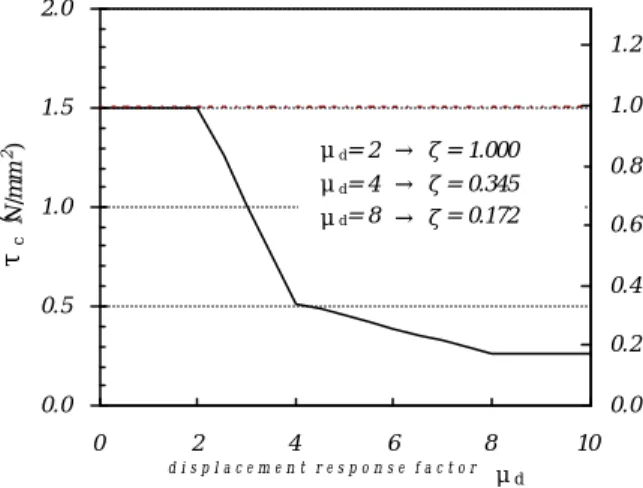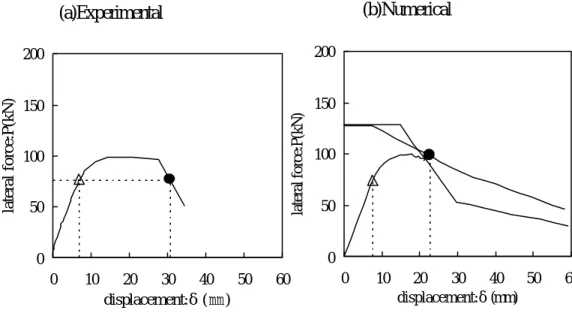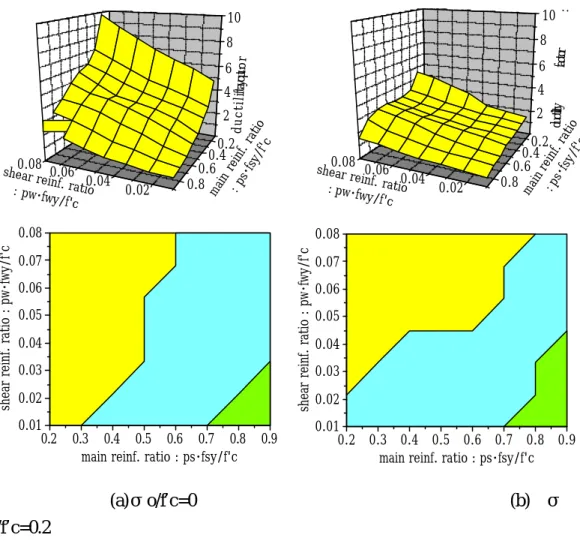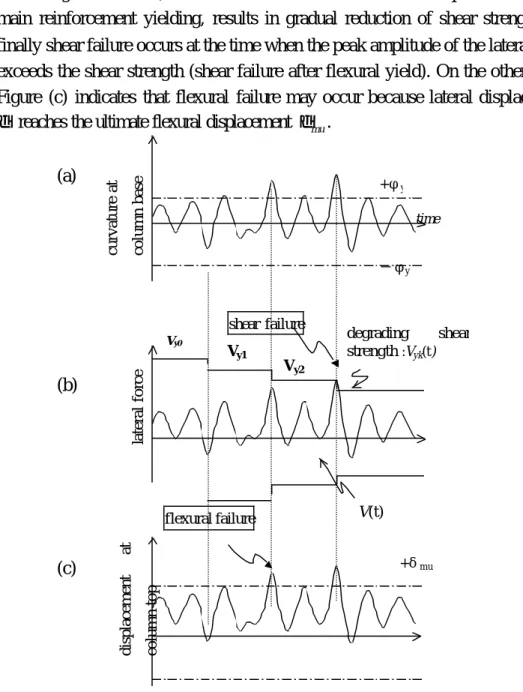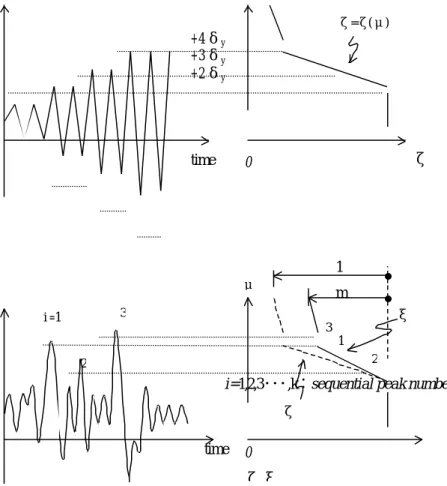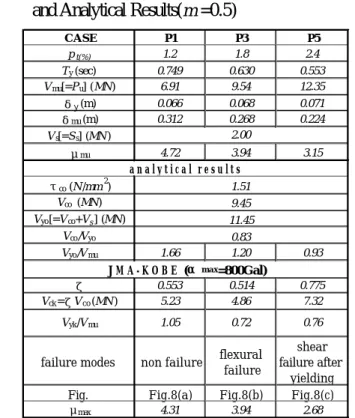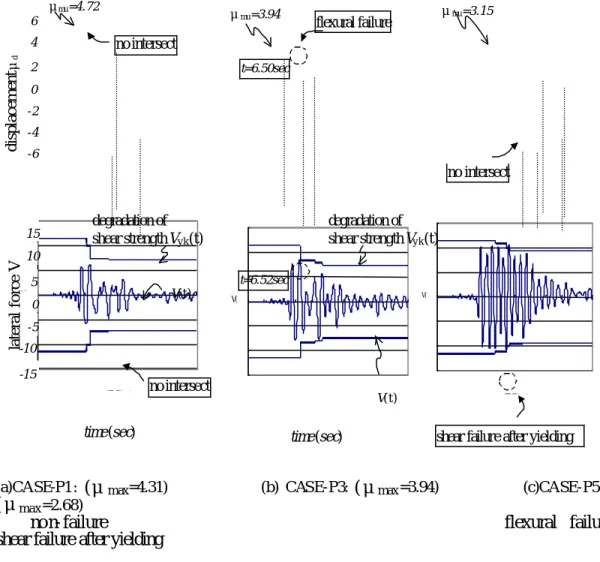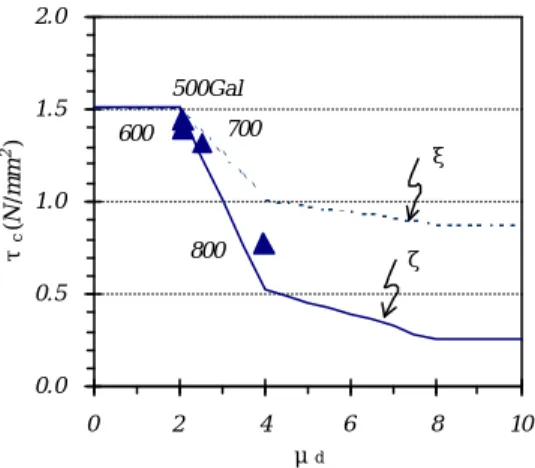Ductility and Failure Modes of Single Reinforced Concrete Columns Hiromichi Yoshikawa1 and Toshiaki Miyagi2
Key Words:
seismic capacity design, reinforced concrete column,
failure modes, deformational ductility, flexural failure, shear failure, shear failure after flexural yielding, shear-degrading curve,
nonlinear dynamic analysis, random deformation history
1 Dept. of Civil Engrg., Musashi Inst. of Tech., Tokyo, Japan.
2 Inst. of Tech., Tokyu Construction Co., Sagamihara-City, Japan.
Ductility and Failure Modes of Single Reinforced Concrete Columns
Hiromichi Yoshikawa3 and Toshiaki Miyagi4
Abstract
The main purpose of the seismic analysis of structures is to assess the level of risk associated with loss of serviceability, restorability and collapse. With regard to a reinforced concrete bridge column, it is extremely important to identify failure modes and to qualify the deformational ductility from the point of the capacity design methodology (Paulay and Priestley (1992)).
In this paper, types of failures of single reinforced concrete columns are classified as flexural failure, shear failure after yielding of longitudinal reinforcement, and shear failure.
Procedures to determine failure modes are presented by comparing P−δ curve (push-over behavior) and the degrading capacity of shear strength along the deformational history.
Nonlinear dynamic analysis is also carried out for reinforced concrete columns
3 Dept. of Civil Engrg., Musashi Inst. of Tech., Tokyo, Japan.
4 Inst. of Tech., Tokyu Construction Co., Sagamihara-City, Japan.
subjected to the recorded time history of strong seismic actions. The shear-degrading curve proposed by Priestley et al. (1996) is extended to a case of random deformation history to cope with actual seismic excitation. The proposed method is compared with data of experimental works and numerical simulations are carried out.
Introduction
Seismic capacity of a substructure supporting superstructure is examined by comparing response values (load or deformation) by earthquake motion with its strength or ductility in many cases. For example, comparison of response deformation and ductility performance of a structural system is a typical technique of seismic capacity assessment. Both these works are usually performed separately during a design procedure. However, this is not considered to be a rational method, especially in cases where seismic actions and structural ductility are affected to each other during a strong earthquake.
When considering reinforced concrete structures, it is important to clearly define a failure mode and to appropriately assess the seismic capacity for each failure mode. Flexural failure and shear failure for reinforced concrete bridge columns can be easily judged. However, a failure mode in-between these (“shear failure after flexural yielding”) is still open to question and often become critical in seismic design (AIJ Design Guidelines (1990), An and Maekawa (1998)).
In this study, three failure modes of a single reinforced concrete column are defined, and identification methods in static analyses and assessment methods for ductility factors are proposed. Furthermore, comparison with test results and numerical simulations were performed. A particular discussion focuses on a degradation model of shear strength accompanying large repeated deformation far beyond the yield point of the main reinforcement.
The degradation shear model in dynamic random response is proposed and dynamic nonlinear analyses by spring mass model of a single degree-of-freedom are carried out. The degradation process of structural members during the time history is assessed based on an amount of damage accumulated, then
determination of failure/non-failure as well as failure modes are made, and finally the maximum response displacement is computed. Numerical simulations for actual bridges were performed, which offer useful and interesting information.
Classification of Failure Modes of Single Reinforced Concrete Columns
Now we consider the classification and definition of failure modes of single type of reinforced concrete bridge column subjected to large cyc lic deformation. We firstly consider increased cyclic tests of displacement control type as shown in Figure 1, and define δy at the displacement when longitudinal reinforcement yields and δmu at the displacement of ultimate flexural failure on the envelope curve (P−δ curve).
The shear strength is, on the other hand, gradually reduced due to large cyclic deformation beyond the displacement of yielding of the main reinforcement.
The shear strength are thus denoted as:
Vyo: initial shear strength
Vyk: degrading shear strength due to cyclic loading
Figure 1. upper: Cyclic Behavior of Single Reinforced Concrete Column, lower: Classification of Failure Modes
Now that the failure modes can be defined according to the intersecting relationship between the P−δ curve and the degrading shear capacity envelope (Priestley et al. (1996)). This is
A) Shear failure: Shear failure occurs before the main reinforcement yields B) Shear failure after flexural yielding: Shear failure occurs after the main reinforcement yielding
C) Flexural failure: The P−δcurve and the degrading shear capacity envelope do not intersect till reaching the ultimate flexural point (δ =δmu).
Photo 1. exhibits examples of test specimens failed in each of these failure
displacement δ
load P
longitudinal reinforcement yielded
ductility fcctor 1 μmu
ultimate
(B) shear failure after yilding
δy δmu P
δy δmu (A) shear failure
degradation of shear strength curve envelope curve (P-δcurve)
(C) flexural failure
δy δmu
modes. The type A failure is caused when an excessive quantity of the main reinforcement is arranged or when a quant ity of lateral reinforcement is insufficient, and it has been pointed out that this failure type extremely deteriorates seismic performance. On the other hand, the type C failure means that shear failure does not occur under any excessive input of earthquake motion, and that full ductile performance is maintained. The type B failure (flexural shear failure) located between those types shows the limited ductile shear strength leading to being critical concerning seismic design.
When we define a member ductility ratio µ as µ =δ /δy , the three failure types defined in Figure 1 are classified as follows:
A) shear failure : µ<1
B) shear failure after yielding : 1< µ <µmu (1)
C) flexural failure : µ=µmu
shear failure(C05) shear failure after yielding(C10) flexural failure(C20)
Photo 1. Test Examples for Three Failure Modes (Hattori et al. 1998)
Static Nonlinear Analysis and Shear Strength Deformational Analysis
We will perform deformational analyses of single reinforced columns to obtain P−δ curves. The lateral displacement δ includes contributions of flexural deformation δflex, shear deformation δshear and rotating displacement
pullout
δ caused by pulling out the main reinforcement at the column base. Namely,
pullout shear
flex δ δ
δ
δ = + + (2)
As analytical conditions for materials, a model was applied as the concrete constitutive law in which a confining effect by lateral reinfo rcement is reflected, and the constitutive law of longitudinal reinforcement was assumed to be the tri- linear typemodel. Shear deformation δshear was neglected in the present study.
We assumed that plastic hinge is formed in the zone from the column base to 1.0d (d is an effective height of column cross-section). The rotating displacement
pullout
δ caused by pulling out the main reinforcement was calculated by applying the conventional equation.
Shear Strength by Modified Truss Analogy
The well-known modified truss analogy was applied for the calculation of shear strength in this study. This means that shear strength is obtained by summing shear strength by lateral reinforcement Vs and strength of concrete shear resisting mechanisms Vc (for example, JSCE Specification (1996)). In this paper, the following expressions are used to consider initial shear strength and degrading shear strength separately.
initial shear strength :Vy0 =Vs+Vc0 (3-a)
degrading shear strength due to cyclic loading:Vyk =Vs +Vck (3-b)
The shear strength by lateral reinforcement Vs is calculated based on the truss analogy by the following equation:
Vs =Awfwyzcotθ/s (4)
In which Aw is the total area of shear reinforcement arranged in spacing s, and θ is a compressive strut angle.
It has been pointed out that the reduction of shear strength accompanying cyclic excessive deformation is caused by degradation of the component of concrete contribution Vc0. The symbol Vck is used as the strength in the degradation process. Here we introduce the degradation curve proposed by Priestley et al. (1996) as shown in Figure 2.
In Figure 2, the left vertical axis represents the shear strength τc, the right vertical axis the shear degradation factor ζ obtained by dividing shear strength Vck by the initial shear strength Vc0. The initial value of this degradation factor ζ is equal to 1, and ζ <1 for the larger deformation which is expressed such that ζ =ζ(µd). Thus, the relationship between the initial shear strength τc0 and the degrading shear strength τck as well as between Vc0 and Vck are simply written as
0 c
ck V
V =ζ , τck =ζτc0 (5) In Eq. (5), both of shear strengths Vc0 and τc0 can be related such as
e c
c A
V0 =τ 0 and Vck =τckAe through the effective sectional area of a member Ae.
Figure 2. Modeling of Shear Strength Degradation Curve (Priestley et al. (1996)) Shear Strength by New RC Equation
The New RC equation in AIJ Design Guidelines (1990) allows calculating the shear strength by superposing the truss mechanism and arch mechanism as shown in Eq. (6).
c wy
w
y Bzp f B H f
V 0 = cotθ + tanθ(1−β)( /2)ν ' (6)
where, Band H : section width and height (mm), respectively, z : effective height (= jd), pw: lateral reinforcement ratio (%), fwy: yield strength of lateral reinforcement (N/mm2), β : concrete contribution ratio of compressive force in truss mechanism, ν : effective concrete factor, f'c : concrete compressive strength (N/mm2), N: axial force (N) and n: axial force ratio (= N/BHf'c).
The concrete degrading process is expressed by reducing the effective
0.0 0.5 1.0 1.5 2.0
0 2 4 6 8 10
d i s p l a c e m e n t r e s p o n s e f a c t o r μd
τc(N/mm2)
0.0 0.2 0.4 0.6 0.8 1.0 1.2
ζ
μd= 2 → ζ= 1.000 μd= 4 → ζ= 0.345 μd= 8 → ζ= 0.172
concrete factor ν and an angle of concrete compressive struts in the truss mechanism as a single function of rotating angle Rp in the plastic hinge zone of column base. This proposed formula reflects the new theoretical consideration to be proven by a wide range of experimental database).
Comparison with Test Results and Numerical Simulation
Comparison with Test Results
In order to verify the validity of this proposed technique, we compare analytical results with loading test results using three specimens referred to as C05, C10 and C20 (Hattori et al. (1998)). Each specimen having cross-sectional dimensions of 320 mm×320 mm and a shear span ratio of 4.05 were designed to arrange reinforcements for the above-mentioned three types of failure mode (see Photo 1 again).
The analytical result of specimen C05 by the proposed method shows that deformational behavior is quite similar to the test result and predicted the shear failure identical to the test. The analytical results of specimen C10 using two shear strength degradation curves intersected nearly at the same points on P−δ envelop curve, and coincided with the failure mode of the test results (shear failure after flexural yielding). The analysis of specimen C20 shows that both of the shear degrading curves do not intersect with P−δ curve and the failure mode is assessed to be of the flexural failure.
As an example the case for specimen C10 that failed in shear after yielding of longitudinal reinforcement, is shown in Figure 3, where the test result and the
analytical prediction are compared.
Figure 3. Failure Mode and Ductility for Specimen C10
Numerical Simulation
It is known that the failure mode and ductility of a member are affected by the ratio of flexural yield strength to shear strength, concrete contribution of shear strength, main reinforcement ratio, lateral reinforcement ratio, axial force level, and so on. Then parametric simulations are carried out based on this proposed technique for those affecting factors. The shape of column used is identical to the above specimens (A=320 mm×320 mm and shear span ratio a=4.05). The New-RC Guideline equation was applied to calculate the shear strength-degrading curve.
Figure 4 shows the member ductility ratio vs. the ratio of shear strength to flexural strength with parametric range used in this analysis. Here we denote the
(a)Experimental
0 50 100 150 200
0 10 20 30 40 50 60
displacement:δ(mm)
lateral force:P(kN)
(b)Numerical
0 50 100 150 200
0 10 20 30 40 50 60
displacement:δ(mm)
lateral force:P(kN)
ratio of shear strength to flexural strength as Vy0/Vmu (flexural capacity Vmu of column obtained by dividing the ultimate flexural moment Mmu at the column base by the shear span a). It can be seen that the failure mode shifts from flexural to shear mode and ductility factor of columns decreases, as the ratio of shear strength to flexural strength becomes smaller.
From this figure, it may be suggested that each failure mode can be approximately estimated by the ratio of shear strength to flexural strength in such a way that
Shear failure: ratio of shear strength to flexural strength<0.8 Shear failure after yielding of longitudinal reinforcement:
0.8<ratio of shear strength to flexural strength<1.5 Flexural failure: 1.5<ratio of shear strength to flexural strength Figure 5 illustrates relationship among the main reinforcement ratio, the lateral reinforcement ratio and the member ductility factor for two axial force levels. This figure implies that with increase of the axial force applied to the member, its ductility factor becomes lower and the failure mode tends to shift from the flexural to the shear mode.
(a)σo/f’c=0 (b) σ o/f’c=0.2
Figure 5. Evaluation of Failure Modes and Ductility Ratios for Two Axial Level in Relation of Main/Shear Reinforcement Ratio
Failure and Shear Degradation in Dynamic Random Process Classification of Failure Modes in Random Process
Now we consider an expansion of the proposed method to random response of concrete columns subjected to a seismic load shown in Figure 6, illustrating dynamic nonlinear response. FIGURE 6 schematically depicts the time history response for (a) curvature at column base, (b) lateral force acting on the column base and (c) lateral displacement at column top. Figure (b) describes that
0.8 0.60.40.2 0.04 0.02
0.08 0.06
2 4 6 8 10
shear reinf. ratio : pw・fwy/f'c
ductility factor : μ
main reinf. ratio : ps・fsy/f'c 0.8
0.60.40.2 0.04 0.02
0.08 0.06
2 4 6 8 10
shear reinf. ratio : pw・fwy/f'c
ductility factor : μ
main reinf. ratio : ps・fsy/f'c
0.2 0.3 0.4 0.5 0.6 0.7 0.8 0.9 0.01
0.02 0.03 0.04 0.05 0.06 0.07 0.08
main reinf. ratio : ps・fsy/f'c
shear reinf. ratio : pw・fwy/f'c
0.2 0.3 0.4 0.5 0.6 0.7 0.8 0.9 0.01
0.02 0.03 0.04 0.05 0.06 0.07 0.08
main reinf. ratio : ps・fsy/f'c
shear reinf. ratio : pw・fwy/f'c
the damage at the base, where curvature at base exceeds the displacement of the main reinforcement yielding, results in gradual reduction of shear strength and finally shear failure occurs at the time when the peak amplitude of the lateral force exceeds the shear strength (shear failure after flexural yield). On the other hand, Figure (c) indicates that flexural failure may occur because lateral displacement δ reaches the ultimate flexural displacement δmu.
(a)
(b)
(c)
Figure 6. (a) Curvature at Column Base, (b) Lateral Force Acting on Column Base and (c) Lateral Displacement at Column Top in Time History
Response
curvature at column base
time
displacement at column top
flexural failure
+δm u
Vy1 Vy0
Vy2
degrading shear strength :Vyk(t) shear failure
V(t)
lateral force
+φy
−φy
−δm u
Therefore the failure modes for the dynamic random response can be classified into the same manner as previously defined in addition to the non- failure. Determination of dynamic failure modes and maximum response displacement µmax can be summarized as follows:
A) Shear failure: V(t)>Vy0(t) →
max <1 µ
B) Shear failure after yielding of longitudinal reinforcement:
V(t)>Vyk(t) → µmu
µ <
< max
1
C) Flexural failure: V(t)<Vyk(t),µd >µmu → µmu=µmax D) Non-failure V(t)<Vyk(t) , µd <µmu →
d
mu µ
µ =
In these equations µmax denotes the maximum response displacement normalized by δy and likewise µd =δ /δy . The value of µmax is the maximum response displacement in the case of non-failure, or the member ductility factor once the failure occurs.
Dynamic Shear Strength
It is supposed that the shear-degrading model as discussed above has been experimentally identified by static tests (say, quasi-static tests by gradually increased displacement control). In programs of these tests, deformational behavior and ductility are observed on each positive and negative side of displacement, successively followed by δ =+1δy , δ =−1δy δ =+2δy
δy
δ =−2 δ =+3δy δ =−3δ . Therefore we propose the following damage model utilizing a cumulative damage theory to evaluate the degradation of shear
strength during the dynamic random process.
As shown in Figure 7, a factorξ is newly introduced in order to express the degradation of shear strength when a column is damaged by a single attack in earthquake wave. The original degrading factor ζ shown in Figure 2 is modified by multiplying a factor m in the form
<2
µd : ξ =1 4
2≤µd < : ξ=−0.3275mµd +0.655m+1 8
4≤ µd < : ξ =−0.04325mµd −0.518m+1 µd
≤
8 : ξ =−0.828mµd +1 (7)
The modification factor m is supposed to be in a range of 0<m<1, and )
, (m µd ξ
ξ = is referred to as the degrading factor due to a single attack, which is different from the standard degrading curve ξ =ξ(µd). Here in the present paper, the factor m is assumed to be 0.5 as a constant value through the degradation process.
By sequentially numbering suffix i for large deformation amplitude δ (here in this study |δ |>2δy) as i=1,2,3,...,k and designating as ξ1,ξ2,ξ3,...,ξk, the following equation of sequential multiplication leads to the factor ςk.
∏
==
= k
i i k
k
1 3
2
1ξξ...ξ ξ
ξ
ζ
(8)
During seismic motion concrete contributions of shear strength Vck,τck are updated using the degrading factor ζk obtained from Eq. (8).
μ
Figure 7. Degradation Factors for (a) Increased Displacement Control and (b) Random Response Displacement
Nonlinear Dynamic Analysis
Dynamic Failure Analysis of Bridge Columns
In this section numerical simulation is performed on a single type of bridge column that was heavily damaged in the Hyogo-Ken Nambu Earthquake.
Specifications of cross-sections and calculated properties of members used for simulation are listed in Table 1. Three members are designated as
time +4
1 +4δy
+3δy +2δy
0 1 ζ,ξ
μ
1 m
ζ=ζ(μ) μ
ζ
ξ i=1
2 3
1 μ
2
time
3
ζ +4
-2 -4 0
μ
-2 -4 0
0 1 (a)
(b)
i=1,2,3・・・,k:sequential peak number
Case- P1(Pt =1.2%), - P3(Pt =1.8%) and - P5(Pt =2.4%) , in which Pt denotes the ratio of longitudinal reinforcement.
The bridge column was idealized into a system of a single degree-of- freedom with one- mass to perform a nonlinear dynamic response analysis. A skeleton curve of members in consideration was constructed based on JRA-specifications (1996) and the tri- linear type of Takeda model was used.
Viscous damping coefficient was assumed to be 2%.
Table 1. Properties of Cross-section and Structural Member and Analytical Results(m=0.5)
Earthquake motion observed at the Kobe Ocean Meteorological Observatory (hereafter referred to as JMA-KOBE) was employed as input earthquake ground motion adjusted the maximum acceleration to be 800 Gal. The Newmark-β method (β =1/4) was used as step-by-step integration in the time domain, where the time interval was designated as ∆t =0.02 sec (0.002 sec when stiffness drastically changed). Numerical simulation was then performed and the results are shown in Table 1 and Figure 8 (a) - (c) for comparison. Since
CASE P1 P3 P5
pt(%) 1.2 1.8 2.4
Ty (sec) 0.749 0.630 0.553
Vmu[=Pu] (MN) 6.91 9.54 12.35
δy (m) 0.066 0.068 0.071
δmu (m) 0.312 0.268 0.224
Vs[=Ss] (MN)
μmu 4.72 3.94 3.15
τco (N/mm2) Vco (MN) Vyo[=Vco+Vs] (MN)
Vco/Vyo
Vyo/Vmu 1.66 1.20 0.93
ζ 0.553 0.514 0.775
Vck=ζVco (MN) 5.23 4.86 7.32
Fig. Fig.8(a) Fig.8(b) Fig.8(c)
μmax 4.31 3.94 2.68
failure modes non failure flexural failure
shear failure after
yielding 11.45
0.83
Vyk/Vmu 1.05 0.72 0.76
J M A - K O B E (αm a x=800Gal) 2.00
a n a l y t i c a l r e s u l t s 9.45 1.51
μ μ μ
the seismic input data is based on the Hyogo-Ken Nambu Earthquake, the extremely large excitation has completed in the first 20 sec., and that the failure or non-failure was determined during the time of t=5〜10 sec in all cases.
Case-P1 of Figure 8 shows that several large deformations over µd =2 lead to reducing the shear degrading factor up to ζk =0.558, however neither shear failure nor flexural failure occurred after all (non- failure: µmax =4.31). On the other hand, Case-P3 in Figure (b) illustrates that lateral displacement reached the ultimate flexural ductility at the time of the initial large deformation (µd =µmu), causing a flexural failure (µmax =3.94). It is interesting to see that the degrading shear strength and the response lateral force intersected in the same amplitude. Case-P5 in Figure (c) implies a typical shear failure after flexural damage. Although the response displacement µd was not large and then the degradation of shear strength was limited to ζk =0.783, the shear failure was initiated when t=9.16sec due to excessively large lateral force V (shear failure after flexural yielding: µmax = 2.67 ).
In this manner, differences in dynamic failure modes and maximum response displacements are clearly recognized because of the difference of static and dynamic character istics accompanying the difference of amount of the longitudinal reinforcement, though the earthquake excitation and the structural configuration are identical. It is also found in these three cases that ratios of shear strength to flexural strength Vy0/Vmu are getting small in order of P1, P3 and P5 (see TABLE 1), and then the failure mode shifted from non-failure (µmax =4.31), flexural failure (µmax =3.94), and shear failure (µmax =2.67).
Ratio of shear strength to flexural strength is expected to be useful to determine the failure mode in the dynamic analysis. These analytical results mean that while the increase of longitudinal reinforcement improves the static loading capacity, the dynamic seismic capacity may be sometimes affected adversely. It may be concluded that the columns analyzed are to be high strength but low seismic capacity.
TIME(sec) V( V(
TIME(sec) V(
(a)CASE-P1: (μmax=4.31) (b) CASE-P3: (μmax=3.94) (c)CASE-P5:
(μmax=2.68)
non- failure flexural failure
shear failure after yielding
Figure 8. Time History Response of Lateral Displacement (upper) and Lateral Force (lower) under JMA-KOBE
(αmax =800 Gal) Numerical Simulation
Next we again employed earthquake motion of JMA-KOBE 1995, in which the maximum acceleration varied from 500 to 900 Gal and the contribution Vs due to the lateral reinforcement changed as Vs =0.01, 0.5,1.0,1.5,...,5.0 MN so as to carry out nonlinear parametric dynamic analyses. Figure 9 and Figure 10 are examples of parametric simulations, taking focus on the degradation process of shear strength in time-histories
Figure 9 shows the degrading process of concrete contribution by the
6 4 2 0 -2 -4 -6
15 10
5 0 -5 -10 -15
μmu=3.94
μmu=4.72 μmu=3.15
no intersect
V(t)
flexural failure
t=6.50sec
t=6.52sec
degradation of shear strength Vyk(t)
V(t)
time(sec) degradation of
shear strength Vyk(t)
lateral force Vdisplacementμd
no intersect
time(sec)
no intersect
shear failure after yielding
degrading factors ζ and ξ in i=1,2,3, and the degrading process of concrete contribution (shear strength:Vck and shear strength:τck) of the shear strength can be examined. It was found that the number of the large deformation for µd ≥ 2 and the finally obtained ζk depend on the characteristics of the earthquake input motion as well as the structure configuration.
Figure 10 shows the degrading shear strength τck taking the maximum ground acceleration as a parameter. It was found that, as the maximum input acceleration (αmax: indicated in the figure) increases, the column causes the more damage to become the lower shear strength τck.
(a) (b)
Figure 9. (a) Relationship of Response Displacement and Degradation Factors ξk and ζk, and (b) Response Displacement in The Time History
0 1 2 3 4 5
0 0.5 1
ζ,ξ
μd
ξ
ζ JMA-KOBE(P3,αmax=800Gal)
0 5 10 15 20
time(sec) i=1
3 2
Figure 10. Comparison of Degrading Shear Strength τck and Maximum Deformation Response ratio µd [ f'c=27N/mm2 → τco =1.51N/mm2]
Conclusions
Through the discussions so far we summarize the conclusion of this paper as follows:
Failure modes for a single reinforced concrete column were classified into three types: shear failure, shear failure after flexural yielding and flexural failure.
It is especially difficult to model the shear failure after flexural yielding which has been discussed from the viewpoint of seismic design procedure. The modified truss analogy incorporating concrete degrading models proposed by Priestley and New RC equation from AIJ Design Guidelines were utilized to predict the degrading process up to the shear failure.
Comparison of this proposed technique with the results of static loading tests using three specimens (increased displacement control test) indicated generally good agreement concerning the failure mode and displacement ductility.
The analytical results by parametric simulation suggested usefulness of the ratio of shear strength to flexural strength.
In order to apply this analytical technique to random responses of a
0.0 0.5 1.0 1.5 2.0
0 2 4 6 8 10
μd
τc (N/mm2)
500Gal
600 700
800
ξ
ζ
column subjected to a seismic load, the concrete degrading model proposed by Priestley was modified in terms of the cumulative damage model. Furthermore, a dynamic nonlinear response analysis was performed using one mass and single-degree-of- freedom model under recorded seismic action. Reduction of shear strength is updated in the time history, and it became possible to judge either failure or non-failure and to calculate the maximum displacement.
When maximum input acceleration was, for instance, αmax =800 Gal, degrading strength τck got lowered to 0.6 - 0.8 N/mm2 whereas initial shear strength τco of concrete was 1.5 N/mm2. On the other hand, the shear strength τck for seismic design in the current Japanese specifications (JRA Specification and JSCE Seismic Code) is approximately 0.3 - 0.5 N/mm2, which is found to be a more conservative value.
In this modeling, however, the more adequate determination of the factor is necessary, which has been examined in our laboratory by experimental works as well as by the analytical consideration.
Further numerical simulations, taking the quantity of main reinforcement, quantity of lateral reinforcement, types of earthquakes and maximum acceleration as parameters, for actual reinforcement concrete bridge columns need to be performed to obtain more comprehensive numerical information.
References
An, X. and Maekawa, K. (1998). “Shear Resistance and Ductility of RC Columns after Yield of Main Reinforcement.” Journal of Materials, Concrete Structures and Pavements, JSCE, No.585/V-38, 233-247.
Architectural Institute of Japan (1990). Design guidelines for earthquake resistant reinforced concrete buildings based on ultimate strength concept, Japan. (In Japanese)
Hattori, H., Miyagi, T., Masuda, Y., Iketani, K. and Yoshikawa, H. (1998). “Evaluation of Failure Mode and Ductility of Reinforced Concrete Columns.” The 10th Japan Earthquake
Engineering Symposium, Proceedings Vol. 2, 2157-2162. (In Japanese)
Japan Society of Civil Engineers (1996). Standard specification for concrete structures, Seismic Design, JSCE. (In Japanese)
Japan Road Association (1996). Specification for highway bridges, Part V:
Earthquake-resistant design. (In Japanese)
Paulay, T. and Priestley, M.J.N. (1992). Seismic Design of Reinforced Concrete and Masonry Buildings, John Wiley & Sons.
Priestley, M.J.N., Seible, F., and Calvi. G.M. (1996). Seismic Design and Retrofit of Bridges, John Wiley & Sons.

